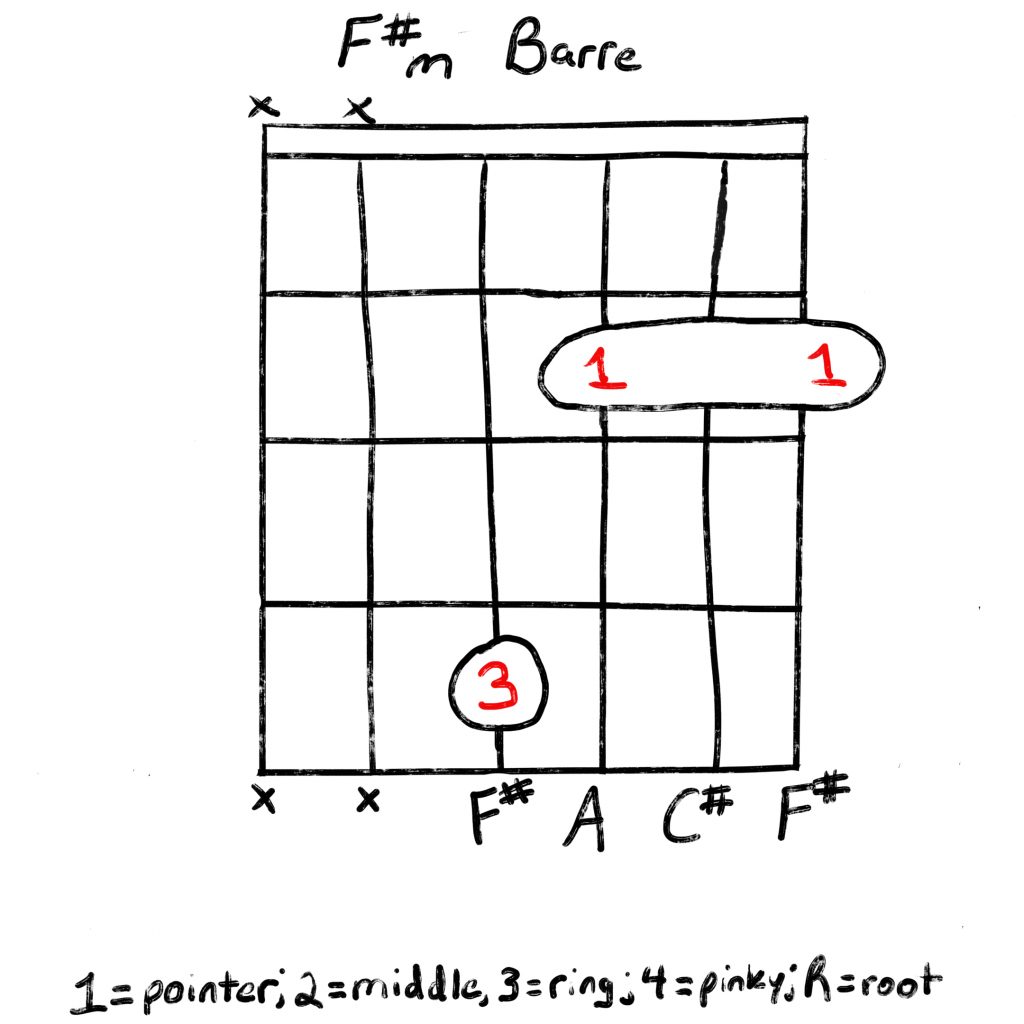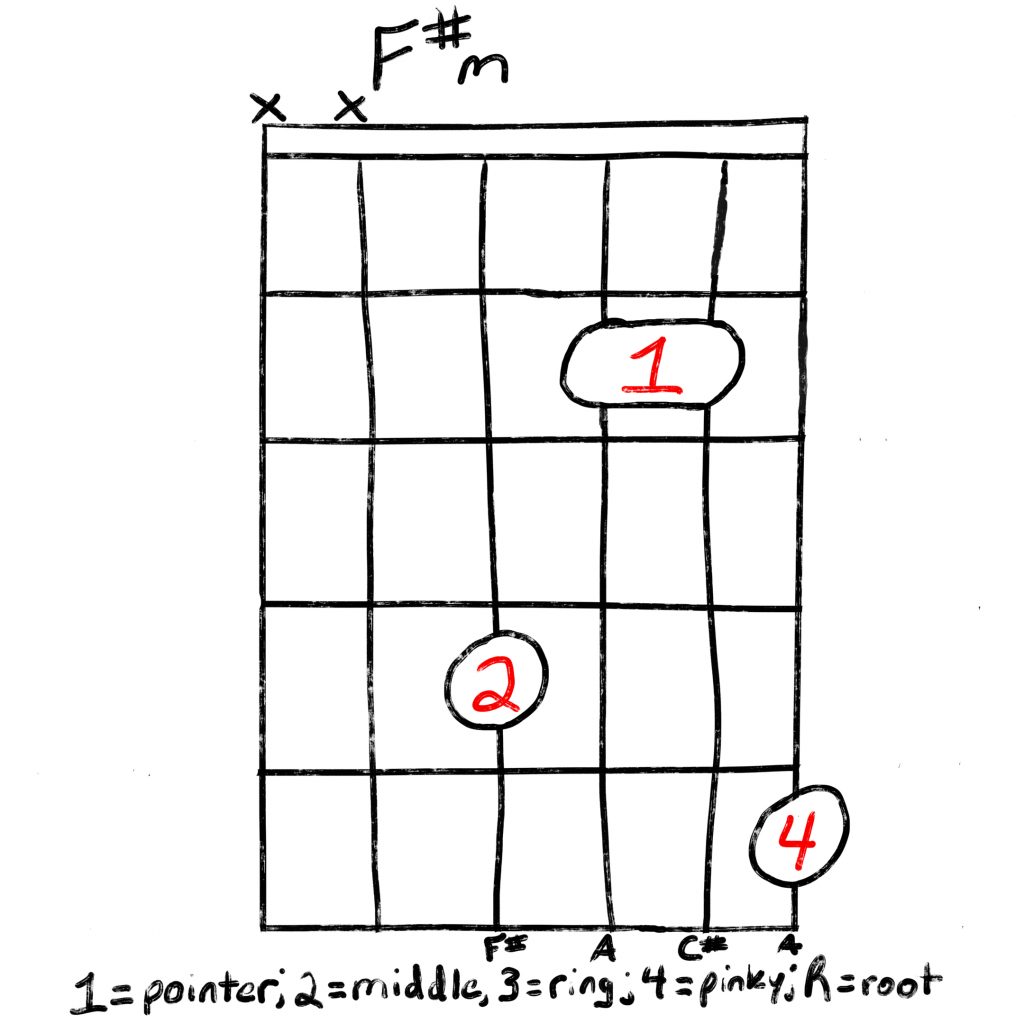The F Chord and F#m guitar chord are often some of the very first barre chords we ever learn as guitarists. It's also not uncommon to be a bit intimidated by them and just skip learning any songs that use them.
But, you don't have to do that. In fact, you can play the F#m guitar chord without a barre at all. This lesson today will give you a quick way to play this chord and an easy way to work yourself up to barre chords.
If you already play barre chords, here are a few variations on the F#m you can add to your arsenal.
Let's dive into the lesson!
How To Play The F#m Guitar Chord

Let's start out with, probably, the easiest version of F#m. This one is great for those who may have not quite mastered barre chords yet.
This is a fine chord for beginners or as an accent to a progression but can sound a bit thin since it lacks any bass notes.
- index finger (1) on the C# note of the high e string on the 9th fret
- middle finger (2) on the A note of the B string on the 10th fret
- ring finger (3) on the F# note of the G string on the 11th fret
- mute the rest of the strings
Variations Of The Chord
This version of the chord is a great entryway into playing barre chords. You will still utilize the barring technique but do not have to do so across all of the strings.

- index finger (1) barred across the A, C#, and F# notes of the G, B, and e strings on the 2nd fret
- mute the rest of the strings

This is the exact same fingering as above with an additional F# bass note thrown in for a little more body to the chord.
- index finger (1) barred across the A, C#, and F# notes of the G, B, and e strings on the 2nd fret
- ring finger (3) on the F# note of the D string on the 4th fret
- mute the rest of the strings
Now that you have worked up your finger strength a bit with barring 3 strings, you can work your way up to 5.

This is a moveable chord. Meaning, you take the Am shape and barre the fret above it.
- index finger (1) barred across the A, D, G, B, and e strings on the 9th fret
- middle finger (2) on the A note of the B string on the 10th fret
- ring finger (3) on the C# note on the G string on the 11th fret
- pinky finger (4) on the F# note on the D string at the 11th fret
- mute the low E string
Once you have mastered the above formations, this should be no problem. This version of the F#m guitar chord is the commonly used version.

This is another moveable chord. You use an Em barre chord shape on the 2nd fret.
- index finger (1) barred across all 6 strings on the 2nd fret
- ring finger (3) on the C# note on the A string on the 3rd fret
- pinky finger (4) on the F#m note of the D string on the 3rd fret
The Theory Behind It
Knowing the chord shapes is one thing. To really get a firm grasp on how guitar music works, it helps to know a bit of guitar theory. Let's quickly cover how to build you own chords using the notes on your guitar neck.
Before we can make a minor chord, we must first know how to make a major chord using a major triad. A major triad is the I, III, and V, or 1st, 3rd, and 5th, notes of the F# major scale. So an F# chord uses:
- F# (I)
- A# (III)
- C# (V)

The F# major scale looks like this:

A minor chord uses the same F# major scale but a slightly different chord formula. We use the I and V from the major triad, but instead of a III, we use a bIII, or flat 3rd.
The formula for a F#m chord look like:
- F# (I)
- A (bIII)
- C# (V)
Complementary Chords
You've put in the work to learn the F#m chord now let's have some fun with it. Let's build a chord progression to go with it.
We approach building a chord progression similarly to the way we build a chord. However, instead of a note scale, we use a chord scale.

The chords available in a F# major chord scale are:
- F#m (i)
- G#m dim (ii°)
- A (III)
- Bm (iv)
- C#m (v)
- D (VI)
- E (VII)
Note: when a scale degree is lower case (example "iii") that means it is a minor chord. When a note contains the degree symbol (°) that means it is a diminished chord.
One of the most commonly used chord progressions in modern music is the I - V - IV - III progression. Since this is a minor scale we will use i - v - VI - III, or F#m - C#m - D - A.
This is how you play that progression:




One More F#m Chord For The Road
This last version builds on the original simple barre chord from the beginning. We simply add a high A note using our pinky. It's a subtle change but can make a nice change to a chord progression.

- index finger (1) barred across the A and C# notes on the G and B string on the 2nd fret
- middle finger (2) fretting the F# note on the D string at the 4th fret
- pinky finger (4) fretting the A note on the high e string at the 5th fret
- mute the low E and A strings
Songs That Have The F#m Chord
Here are some popular songs across multiple genres that have an F#m chord in them:
- Someone Like You by Adele
- Don't Matter by Akon
- Girl on Fire by Alicia Keys
- Pompeii by Bastille
- Halo by Beyonce
- Sangria by Blake Shelton
- Galway Girl by Ed Sheeran
- My Immortal by Evanescence
- Hey Jealousy by Gin Blossoms
- My Life Would Suck Without You by Kelly Clarkson
- Valentine by Kina Grannis
- Numb by Linkin Park
- Bitch by Meredith Brooks
- Something In The Way by Nirvana
- Wonderwall by Oasis
- Crazy Train by Ozzy Osbourne
- So What by Pink
- Boys Don't Cry by The Cure
- Ocean Avenue by Yellowcard
Final Word
Hopefully, we've been able to help you overcome the dreaded F#m chord. You've learned a variety of ways to play it, as well as how to make your own variations and chord progressions.
Now, back to playing!

Leave a Reply